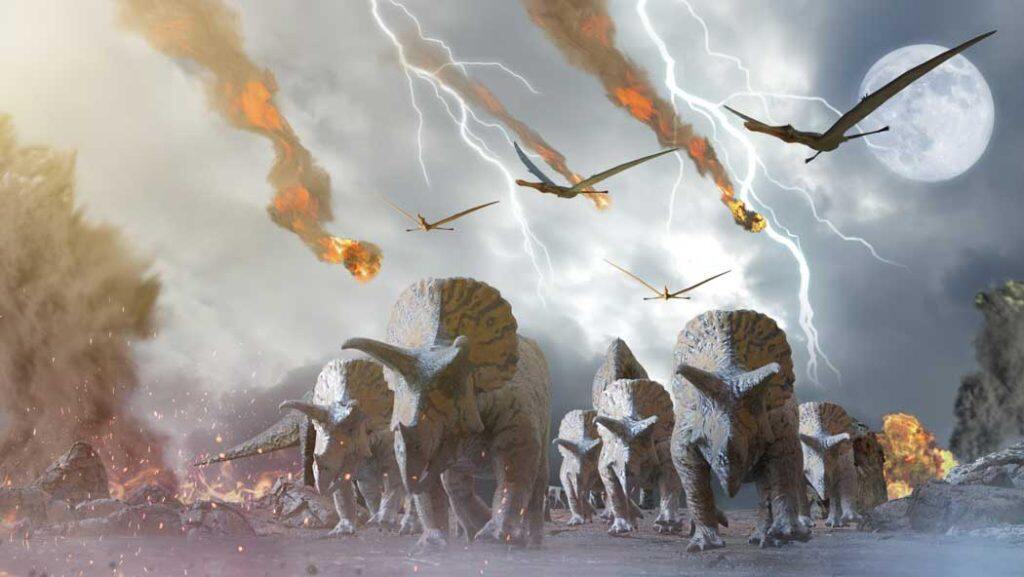

Non-avian dinosaurs were probably in decline long before an asteroid smashing into the Yucatan Peninsula 66 million years ago sealed their fate, according to a University of Alberta paleontologist who says the ancient tale is chronicled at three stops on an astonishing three-hour drive along the Red Deer River.
This tour of Alberta’s prehistoric past takes its lead from a 2021 study by an international research team that included input from Phil Currie. The study suggests the failure of dinosaurs to recover from the cataclysmic asteroid impact was amplified by their inability to adapt to a changing environment.
Currie explains the idea behind a gradual extinction first surfaced four decades ago, shortly after it became generally accepted that the impact of a large asteroid at Chicxulub, Mexico, was responsible for a rapid and catastrophic annihilation of dinosaurs at the end of the Cretaceous Period.
“Since then, some experts argue that there was no catastrophe — that that’s a red herring and dinosaurs died out slowly for other reasons, although they may have been finished off by the asteroid strike. Others feel it happened very rapidly,” he says.
“Either way, Alberta is a pretty key place in settling this.”
Tracing a trail of gradual extinction
Currie and a team led by Fabien Condamine from the Institute of Evolutionary Science of Montpellier, France, analyzed 1,600 dinosaur fossils to assess speciation — when a group within a species develops its own unique characteristics — and extinction rates for six major dinosaur families found in Alberta: Ankylosauridae, Ceratopsidae, Hadrosauridae, Dromaeosauridae, Troodontidae and Tyrannosauridae.
“We found they were all definitely in decline, not over a short period of time, the last million years before the end, but over a period of 10 million years before the end starting 76 million years ago,” he says.
This decline can be traced along the Red Deer River, starting at the heartland of Alberta’s Badlands, Dinosaur Provincial Park, southeast of Calgary. There, paleontologists have unearthed more than 50 species of dinosaurs that date back 76 million years.
“It’s hard to imagine an ecosystem today that could support 50 species of large animals, let alone 150 species of other vertebrates including mammals, birds, pterosaurs, lizards, snakes, turtles and fish,” said Currie. “Dinosaur Park is undeniably one of the richest fossil sites for dinosaurs in the world, if not the richest.”
Following along Veterans Memorial Highway (H36), Cretaceous enthusiasts head upstream to the Drumheller region, which is stratigraphically about four million years younger than Dinosaur Provincial Park. There, paleontologists have uncovered only 30 species of dinosaurs, despite the area once hosting a large cross-section of environments.
“You’re looking at fairly big changes over a pretty short distance (145 kilometres) and over a relatively short period of time,” said Currie.
A quick hour-long drive north along Highway 56 splitting the difference between the Red Deer River and the Rumsey Natural Area — home to Canada’s largest remaining undisturbed tract of aspen parkland and some of the most productive waterfowl habitats on the continent — dinosaur hunters will end the tour at Dry Island Buffalo Jump Provincial Park. Its fossil record is representative of a time at the end of the Cretaceous that lasted from 145 million to 66 million years ago, just before the asteroid hit — about 10 million years younger than Dinosaur Provincial Park. By the time the Cretaceous came to a close 66 million years ago, only a dozen dinosaur species remained in Alberta.
“Here in Alberta, it’s quite clear that the number of species is dropping quite radically over the last 10 million years of the Cretaceous,” says Currie.
Declining diversity
Theories abound about why dinosaurs were in decline, but Currie believes the late Cretaceous came with a climatic shift that was less favourable for big animals.
“Big animals have their greatest diversity when you have very stable environments with good climates and lots of varied food resources for them,” he said. “But as soon as the climate deteriorates, the diversity of plants goes down, the diversity of the animals goes down, which especially affects the bigger animals.”
As Currie explains, North America during the Cretaceous was characterized by inland seas that covered much of the continent and stretched from the Gulf of Mexico to the Arctic Ocean. However, mountain ranges growing to the west ultimately pushed the inland seas southward, and the resulting land elevation eventually blocked the warm southern currents from emptying into the Arctic.
“This resulted in a more continental climate, which usually means the reduction in diversity of animals,” he says.
“I believe the asteroid was still the coup de grâce, but I don’t think it would have had the same effect if it had hit 10 million years earlier, when dinosaurs were much more diverse.”
Condamine was a Marie Curie post-doctoral fellow at the U of A in biological science researcher Felix Sperling’s lab.






































